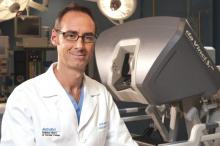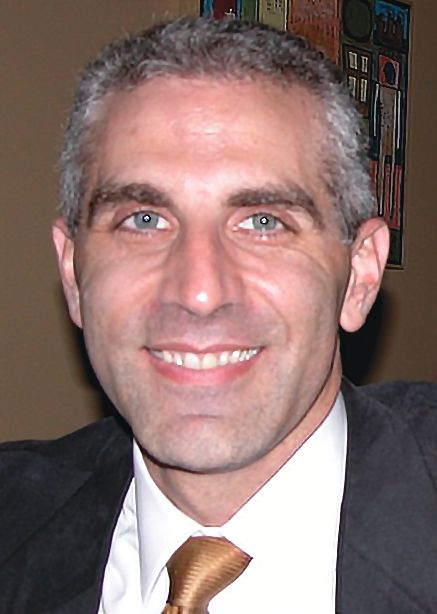User login
The future of vascular surgery – the procedures themselves and the settings in which they occur – will be showcased in “Vascular Robotics; Imaging Systems; Virtual Reality and Guidance; Hybrid Rooms,” on Thursday afternoon.
The session will be co-moderated by Dr. Mark A. Farber, professor of surgery and radiology at the University of North Carolina, Chapel Hill, and director, UNC Aortic Center, UNC Hospitals, and by Dr. Jean Bismuth, associate professor at Houston Methodist Hospital and Methodist DeBakey Heart & Vascular Center.
“In the new paradigm of minimally invasive vascular surgery, image fusion is an application that is essential to all endovascular surgeons,” Dr. Bismuth added. “Understanding its features promotes effective and safe complex procedures. That, along with an appreciation of the evolution in robotics and navigation technologies, has the potential to elevate the integration of the complex hybrid OR. Of great importance for the endovascular surgeon is an appreciation of what the hybrid OR is actually capable of and preparing for the revolution that will further evolve that space over the next 5 years,” Dr. Bismuth emphasized.
Presentations begin with an exploration of robotic technology for vascular surgery. Dr. Fabien Thaveau, professor of vascular surgery, Medical School of Strasbourg, will address the impact of the latest technology on abdominal aortic aneurysms in his talk, “Advances in Robotic Laparoscopic Treatment of AAAs: Value of the Gore Hybrid Graft in Dealing with Complex AAAs.” Dr. Nicholas J.W. Cheshire, professor of vascular surgery, Imperial College, and chief of vascular surgery, Aortic Centre, Royal Brompton Hospital, will continue the discussion by reviewing the current use of robotics and electromagnetic guidance in endovascular procedures, and exploring what developments clinicians might expect to see in the future.
“The relevant issues are the actual imaging equipment, radiation burden, the ease of use of the equipment, a platform that is as noninvasive as possible, and promotes ideal ergonomics, and ultimately optimizes quality and efficiency of patient care,” said Dr. Bismuth.
“A core understanding of advanced imaging techniques is the foundation and the tool which will allow all other technologies to be integrated,” he added. Several speakers focus on the topic of fusion imaging. “Understanding fusion imaging should almost be a take-home message for all at the VEITHsymposium. This is an indispensable tool for all those performing endovascular procedures,” said Dr. Bismuth. Dr. Neal S. Cayne, associate professor of surgery, New York University School of Medicine, and director of endovascular surgery, New York University Medical Center, will describe the pros and cons of the technology in his talk, “Role of 3D Fusion Imaging and Guidance with the Siemens Artis Zeego System for Complex Vascular Interventions: Advantages and Limitations.”
Dr. Cayne will be followed by Dr. Stephan Haulon, professor, Université Paris Sud, and chief of Aortic Center, Hôpital Marie Lannelongue, Paris, who will discuss new developments in advanced fusion imaging and how the technology may be used for managing translumbar type 2 endoleaks and percutaneous distal branch puncture. He will also explain the potential role of fusion imaging for retrograde wiring “when prograde techniques fail during F/B/EVAR.” The fusion imaging portion of the session will continue with a presentation by Dr. Herve Rousseau, professor of radiology, Paul Sabatier University, and chief of department, CHU Rangueil Toulouse, France, on the benefits of fusion imaging for the treatment of type B aortic dissections (TBADs). Next, Dr. Klaus M. Overbeck, Newcastle University and City Hospitals Sunderland, England, will speak on the value of “fusion, re-entry devices, and a variable curvature sheath,” for the endovascular treatment of patients with complicated aorto-iliac occlusive disease. All fusion imaging is not created equal, according to Dr. Giovanni F. Torsello, a vascular surgeon, Charité Universitätsmedizin Berlin, who will address the differences between 2D-3D fusion and 3D-3D fusion, and why these differences are important in endovascular procedures.
A video presentation by Dr. Marc L. Schermerhorn, associate professor of surgery,Harvard Medical School, on “CTA Image Fusion with the Phillips Vessel Navigator to Facilitate F/EVAR” will conclude the presentations.
The future of vascular surgery – the procedures themselves and the settings in which they occur – will be showcased in “Vascular Robotics; Imaging Systems; Virtual Reality and Guidance; Hybrid Rooms,” on Thursday afternoon.
The session will be co-moderated by Dr. Mark A. Farber, professor of surgery and radiology at the University of North Carolina, Chapel Hill, and director, UNC Aortic Center, UNC Hospitals, and by Dr. Jean Bismuth, associate professor at Houston Methodist Hospital and Methodist DeBakey Heart & Vascular Center.
“In the new paradigm of minimally invasive vascular surgery, image fusion is an application that is essential to all endovascular surgeons,” Dr. Bismuth added. “Understanding its features promotes effective and safe complex procedures. That, along with an appreciation of the evolution in robotics and navigation technologies, has the potential to elevate the integration of the complex hybrid OR. Of great importance for the endovascular surgeon is an appreciation of what the hybrid OR is actually capable of and preparing for the revolution that will further evolve that space over the next 5 years,” Dr. Bismuth emphasized.
Presentations begin with an exploration of robotic technology for vascular surgery. Dr. Fabien Thaveau, professor of vascular surgery, Medical School of Strasbourg, will address the impact of the latest technology on abdominal aortic aneurysms in his talk, “Advances in Robotic Laparoscopic Treatment of AAAs: Value of the Gore Hybrid Graft in Dealing with Complex AAAs.” Dr. Nicholas J.W. Cheshire, professor of vascular surgery, Imperial College, and chief of vascular surgery, Aortic Centre, Royal Brompton Hospital, will continue the discussion by reviewing the current use of robotics and electromagnetic guidance in endovascular procedures, and exploring what developments clinicians might expect to see in the future.
“The relevant issues are the actual imaging equipment, radiation burden, the ease of use of the equipment, a platform that is as noninvasive as possible, and promotes ideal ergonomics, and ultimately optimizes quality and efficiency of patient care,” said Dr. Bismuth.
“A core understanding of advanced imaging techniques is the foundation and the tool which will allow all other technologies to be integrated,” he added. Several speakers focus on the topic of fusion imaging. “Understanding fusion imaging should almost be a take-home message for all at the VEITHsymposium. This is an indispensable tool for all those performing endovascular procedures,” said Dr. Bismuth. Dr. Neal S. Cayne, associate professor of surgery, New York University School of Medicine, and director of endovascular surgery, New York University Medical Center, will describe the pros and cons of the technology in his talk, “Role of 3D Fusion Imaging and Guidance with the Siemens Artis Zeego System for Complex Vascular Interventions: Advantages and Limitations.”
Dr. Cayne will be followed by Dr. Stephan Haulon, professor, Université Paris Sud, and chief of Aortic Center, Hôpital Marie Lannelongue, Paris, who will discuss new developments in advanced fusion imaging and how the technology may be used for managing translumbar type 2 endoleaks and percutaneous distal branch puncture. He will also explain the potential role of fusion imaging for retrograde wiring “when prograde techniques fail during F/B/EVAR.” The fusion imaging portion of the session will continue with a presentation by Dr. Herve Rousseau, professor of radiology, Paul Sabatier University, and chief of department, CHU Rangueil Toulouse, France, on the benefits of fusion imaging for the treatment of type B aortic dissections (TBADs). Next, Dr. Klaus M. Overbeck, Newcastle University and City Hospitals Sunderland, England, will speak on the value of “fusion, re-entry devices, and a variable curvature sheath,” for the endovascular treatment of patients with complicated aorto-iliac occlusive disease. All fusion imaging is not created equal, according to Dr. Giovanni F. Torsello, a vascular surgeon, Charité Universitätsmedizin Berlin, who will address the differences between 2D-3D fusion and 3D-3D fusion, and why these differences are important in endovascular procedures.
A video presentation by Dr. Marc L. Schermerhorn, associate professor of surgery,Harvard Medical School, on “CTA Image Fusion with the Phillips Vessel Navigator to Facilitate F/EVAR” will conclude the presentations.
The future of vascular surgery – the procedures themselves and the settings in which they occur – will be showcased in “Vascular Robotics; Imaging Systems; Virtual Reality and Guidance; Hybrid Rooms,” on Thursday afternoon.
The session will be co-moderated by Dr. Mark A. Farber, professor of surgery and radiology at the University of North Carolina, Chapel Hill, and director, UNC Aortic Center, UNC Hospitals, and by Dr. Jean Bismuth, associate professor at Houston Methodist Hospital and Methodist DeBakey Heart & Vascular Center.
“In the new paradigm of minimally invasive vascular surgery, image fusion is an application that is essential to all endovascular surgeons,” Dr. Bismuth added. “Understanding its features promotes effective and safe complex procedures. That, along with an appreciation of the evolution in robotics and navigation technologies, has the potential to elevate the integration of the complex hybrid OR. Of great importance for the endovascular surgeon is an appreciation of what the hybrid OR is actually capable of and preparing for the revolution that will further evolve that space over the next 5 years,” Dr. Bismuth emphasized.
Presentations begin with an exploration of robotic technology for vascular surgery. Dr. Fabien Thaveau, professor of vascular surgery, Medical School of Strasbourg, will address the impact of the latest technology on abdominal aortic aneurysms in his talk, “Advances in Robotic Laparoscopic Treatment of AAAs: Value of the Gore Hybrid Graft in Dealing with Complex AAAs.” Dr. Nicholas J.W. Cheshire, professor of vascular surgery, Imperial College, and chief of vascular surgery, Aortic Centre, Royal Brompton Hospital, will continue the discussion by reviewing the current use of robotics and electromagnetic guidance in endovascular procedures, and exploring what developments clinicians might expect to see in the future.
“The relevant issues are the actual imaging equipment, radiation burden, the ease of use of the equipment, a platform that is as noninvasive as possible, and promotes ideal ergonomics, and ultimately optimizes quality and efficiency of patient care,” said Dr. Bismuth.
“A core understanding of advanced imaging techniques is the foundation and the tool which will allow all other technologies to be integrated,” he added. Several speakers focus on the topic of fusion imaging. “Understanding fusion imaging should almost be a take-home message for all at the VEITHsymposium. This is an indispensable tool for all those performing endovascular procedures,” said Dr. Bismuth. Dr. Neal S. Cayne, associate professor of surgery, New York University School of Medicine, and director of endovascular surgery, New York University Medical Center, will describe the pros and cons of the technology in his talk, “Role of 3D Fusion Imaging and Guidance with the Siemens Artis Zeego System for Complex Vascular Interventions: Advantages and Limitations.”
Dr. Cayne will be followed by Dr. Stephan Haulon, professor, Université Paris Sud, and chief of Aortic Center, Hôpital Marie Lannelongue, Paris, who will discuss new developments in advanced fusion imaging and how the technology may be used for managing translumbar type 2 endoleaks and percutaneous distal branch puncture. He will also explain the potential role of fusion imaging for retrograde wiring “when prograde techniques fail during F/B/EVAR.” The fusion imaging portion of the session will continue with a presentation by Dr. Herve Rousseau, professor of radiology, Paul Sabatier University, and chief of department, CHU Rangueil Toulouse, France, on the benefits of fusion imaging for the treatment of type B aortic dissections (TBADs). Next, Dr. Klaus M. Overbeck, Newcastle University and City Hospitals Sunderland, England, will speak on the value of “fusion, re-entry devices, and a variable curvature sheath,” for the endovascular treatment of patients with complicated aorto-iliac occlusive disease. All fusion imaging is not created equal, according to Dr. Giovanni F. Torsello, a vascular surgeon, Charité Universitätsmedizin Berlin, who will address the differences between 2D-3D fusion and 3D-3D fusion, and why these differences are important in endovascular procedures.
A video presentation by Dr. Marc L. Schermerhorn, associate professor of surgery,Harvard Medical School, on “CTA Image Fusion with the Phillips Vessel Navigator to Facilitate F/EVAR” will conclude the presentations.


